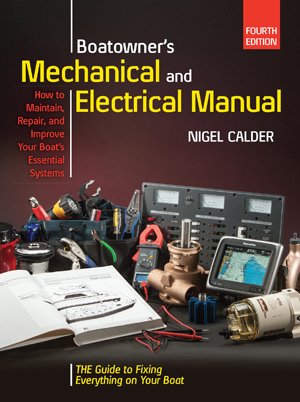Nigel Calder’s Boatowner’s Mechanical and Electrical Manual
With longer days and even the occasional break in the clouds and rain, it is time to start looking forward to more time on the water, and that means tackling onboard projects and maintenance jobs.
 Calder’s masterpiece is considered by many to be a must-have aboard. The new edition pictured here is a worthy purchase for the resourceful boat owner.
Calder’s masterpiece is considered by many to be a must-have aboard. The new edition pictured here is a worthy purchase for the resourceful boat owner.For me, most projects start with phone calls to everyone I know at the marina and yacht club. Has anyone worked on hydraulic steering? Who knows something about wiring a generator or installing electronics? When those overtures fail, or when I am away from the dock when something goes wrong, I turn to the expert: Nigel Calder.
Now in its fourth edition, Nigel Calder’s Boatowner’s Mechanical and Electrical Manual is an indispensable companion for just about every problem you might encounter onboard. I use Calder’s book as a reference these days, but I must confess that when the new edition hit my desk I poured a drink and settled into read it from the beginning. Calder’s writing is accessible, readable, and clear. He peppers the technical with the personal and explains processes and procedures with a clarity that eludes a lot of other marine authors.
The bulk of the text is written from a teacher’s perspective. Calder explains the theories underpinning the systems. He helps you understand how things work rather than just walking you through step-by-step processes for specific tasks.
As a case in point, I was recently in the bilge of our boat trying to uncover a 12-volt issue that had been causing us problems for weeks. Our early guess was that we had a bad battery or two in the system or that the alternator was bad. The dollar signs that come with those potential problems led us to dig in a little deeper before calling in a mechanic.
The cabin floor was littered with the tools, flashlights, and spare parts. My already dog-eared copy of the Boatowner’s Mechanical and Electrical Manual was held open to the chapter on battery systems with a crescent wrench resting across the pages. Volt meter in hand, I systematically worked through the batteries, switches, terminals, and electrical busses. In the course of a few paragraphs, Nigel and I worked together and traced down the voltage loss.
It was a loose nut. A fix that could have cost us at least a few hundred bucks for a professional diagnosis ended up costing us four turns of a wrench.
Any boater who strives to be self-sufficient or even just a little more knowledgeable about how the mechanical systems aboard their boat work needs to shelve a copy of this book. I used an earlier edition to help me design the electrical, the fresh water, and propane systems on our old Cape Dory 27. The new edition has more updated information on electrical efficiency and power generation. This weekend our plan is to design
and price our new solar array that should help keep the generator switch in the “off” position this summer.
I like a teacher who leaves you with a sense of ownership of the material. I like to learn the theory behind the practice and the logic of things. Calder’s writing does just that. I can’t think of a more valuable single resource to keep onboard.


